ポンピドゥー・センターの奥深きコレクション、今回は「フォーヴィスム」「キュビスム」「オルフィスム」という、20世紀初頭の美術界を激震させた三大潮流にスポットを当てます。
印象派、ポスト印象派を経て、芸術はついに抽象表現へと舵を切りました。
色彩の爆発、形態の解体、そして光と色の新たな探求。これらの革新的な試みは、いかにして生まれ、何を残したのでしょうか?
マティスの鮮烈な色彩、ピカソとブラックによる形態の革命、そしてドローネー夫妻が織りなす光と色のシンフォニー。
これらの巨匠たちの作品を紐解きながら、抽象絵画誕生の瞬間を追体験しましょう。
この記事を読み終える頃、あなたはきっと、抽象絵画の奥深さに魅了され、新たな芸術の扉を開いていることでしょう。
さあ、ポンピドゥー・センターの至宝を巡る、時空を超えたアートの旅へ出発です。
Fauvisme フォーヴィスム
フォーヴィスム(野獣派)は、20世紀初頭にフランスで誕生した美術運動で、強烈な色彩と大胆な筆遣いを特徴とします。
1905年のサロン・ドートンヌ展で、アンリ・マティスやアンドレ・ドランらの作品が「野獣(Fauve)のようだ」と批評されたことから、その名がつきました。
フォーヴィストたちは、伝統的な遠近法や写実性を排し、純粋な色彩と自由な表現を追求しました。
彼らは感情を直接キャンバスにぶつけるように描き、自然や人物を大胆にデフォルメしました。
この運動は短命でしたが、後の表現主義や現代美術に大きな影響を与えました。
フォーヴィスムは、色の力で世界を再解釈する芸術の革新であり、今なお多くの人々を魅了し続けています。
Georges Rouault (1871-1958)
ジョルジュ・ルオーはフランスの画家で、表現主義とフォーヴィスムの要素を独自に融合させた芸術家です。
ステンドグラスの修復師としての修行を積んだ経験から、彼の作品には太い黒の輪郭線と鮮やかな色彩が特徴的に現れています。
宗教的主題、サーカスの道化師、売春婦、裁判官などを題材とし、人間の苦悩や精神性を深く探求しました。
カトリックへの強い信仰心を持ち、その宗教観は作品全体を通して明確に表れています。
ルオーの芸術は社会批判的な側面も持ちながら、最終的には人間の尊厳と救済への信仰を表現しています。
彼の暗く重厚な画風は、20世紀美術において独自の位置を占め、後の芸術家たちに大きな影響を与えました。
マティスの友人であり、ギュスターヴ・モローの指導を受けています。
![Georges Rouault (1871-1958)
Parade [détail] (1907-10)](https://tabiparislax.com/wp-content/uploads/2023/05/Georges-Rouault_07.jpg)
Parade [détail] (1907-10)
「Parade [détail](パレード [部分])」は、パステルと水彩を使用することで、アクロバットな動きを表現しています。
ルオーが初期にサーカスをテーマに描いた作品群の一つであり、 彫刻のシルエットのような力強い線描が特徴的です。
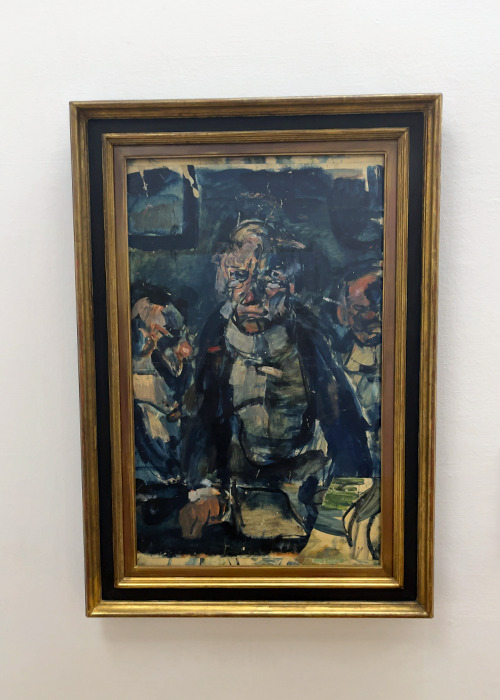
Conférencier (1908-10)
「Conférencier(講演者)」は、講師を悲観的に描いています。
ルオー独特の力強い輪郭線と、深い精神性を感じさせる色彩が特徴で、社会に対する批判的な視点が込められています。
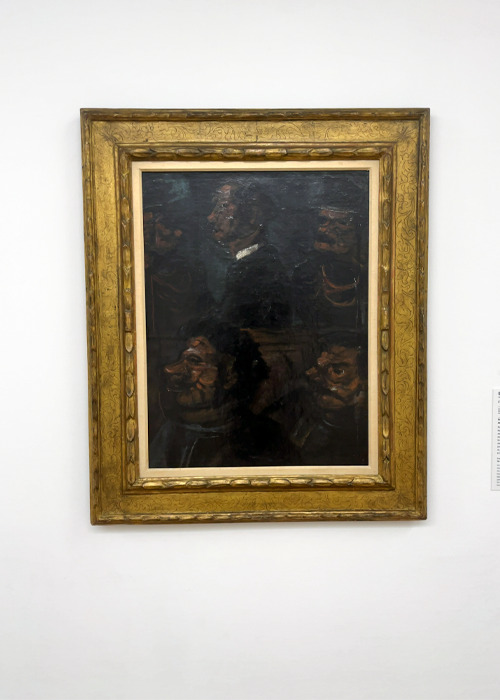
L’Accusé (1908)
「L’Accusé(告発された人)」は、法廷での様子を描いています。
ルオー独特の力強い輪郭線と、深い精神性を感じさせる色彩が特徴で、 社会の底辺に生きる人々への共感と、社会に対する批判的な視点が込められています。
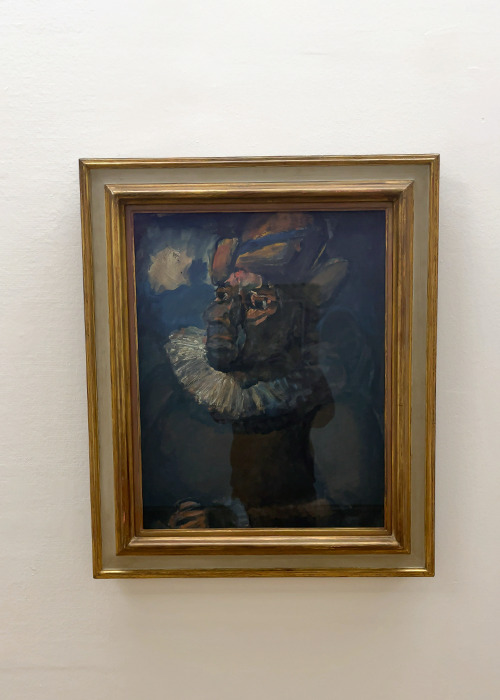
Polichinelle (1910)
「Polichinelle(ポルチネッロ)」は、道化師の悲哀や、社会の底辺に生きる人々の姿を、ルオー独特の力強い線描と深い精神性を感じさせる色彩で描いています。
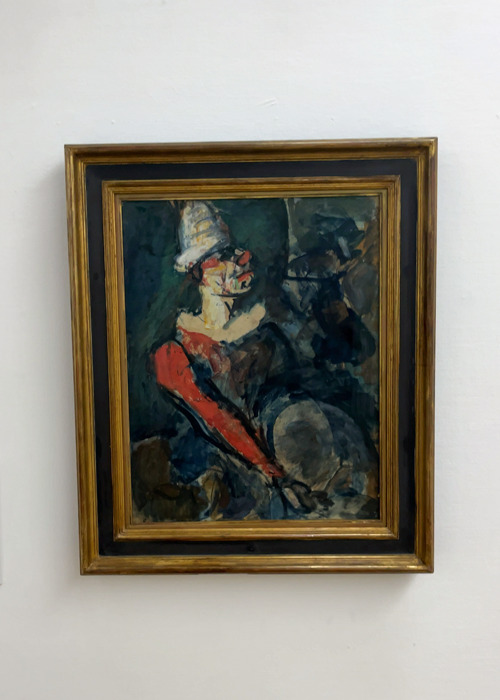
Clown (1910-13)
1903年頃からサーカスをテーマにした作品に取り組んでいました。
この作品もその一環です。
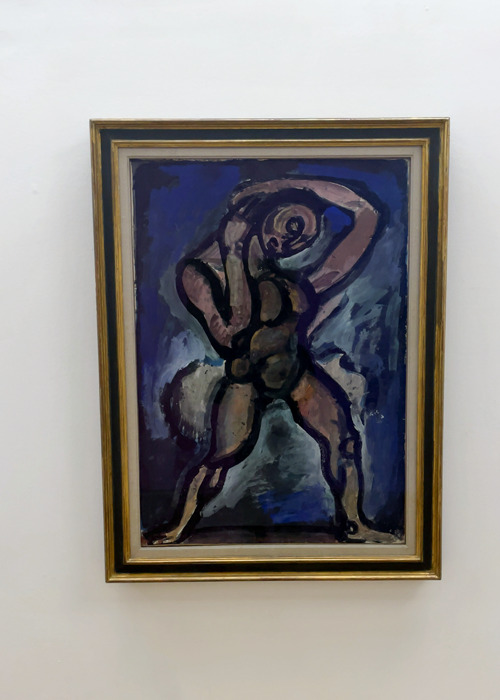
Acrobate (1913)
彫刻のシルエットのような作品です。
アクロバットの動きを、力強い線と暗い色彩で表現しています。
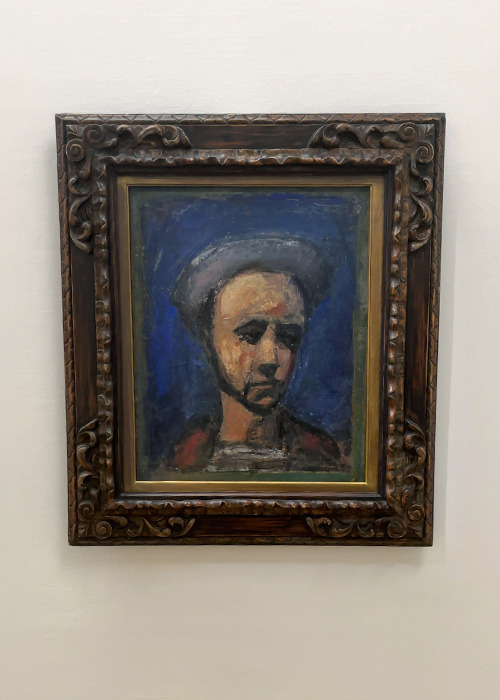
L’apprenti ouvrier (1925)
「L’apprenti ouvrier (1925)(見習い工)」は、ルオーの自画像になります。
労働者階級の姿を通して、人間の尊厳や苦悩を描いています。
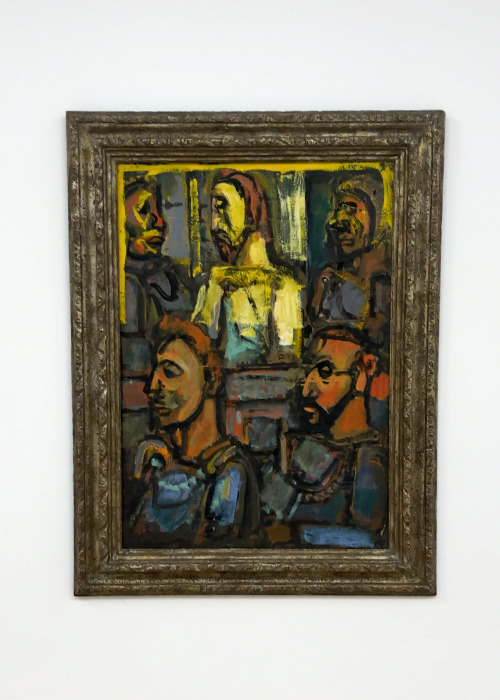
Passion (1929-45)
法廷の様子を描いていますが、宗教的な要素が加わり、中央にキリストを描いています。
L’Accusé (1908)と同じ構図で描かれています。
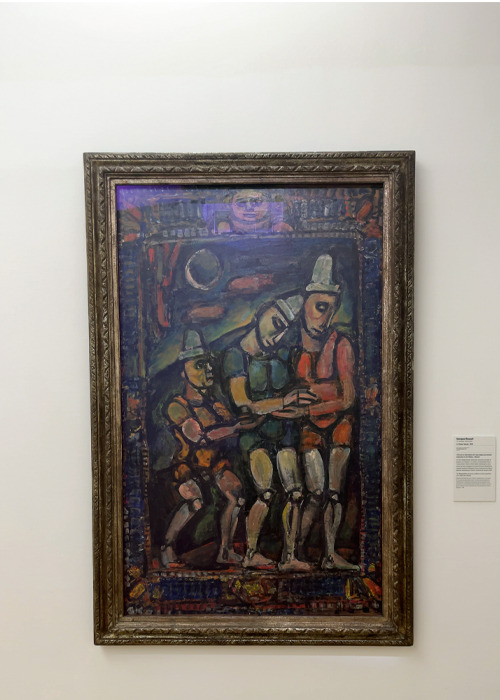
Le clown blessé (1932)
「Le clown blessé (1932)(傷ついた道化師)」は、長年取り組んだサーカスのテーマにおける代表的な作品の1つです。
Albert Marquet (1875-1947)
アルベール・マルケはフランスの画家で、フォーヴィスムの初期メンバーの一人でしたが、のちに独自の穏やかな画風を確立しました。
パリのエコール・デ・ボザールでアンリ・マティスと出会い、親交を深めました。
また、ギュスターヴ・モローの指導を受けていて、デュフィとも友人でした。
初期にはフォーヴィスムの鮮やかな色彩を採用しましたが、徐々により落ち着いた色調と繊細なタッチへと移行していきました。
マルケは特に港や河川の風景画を得意とし、セーヌ川の眺めやフランス各地の港町、また北アフリカなどの旅先で描いた作品が多く残されています。
簡潔な線と抑制された色彩で、風景の本質を捉える優れた能力を持っていました。
彼の作品は、派手さはないものの、光と空気の変化を繊細に表現する大気遠近法と、優れた構図力が特徴です。
静謐さと日常の美しさを見出す彼の視点は、近代風景画における重要な貢献となっています。
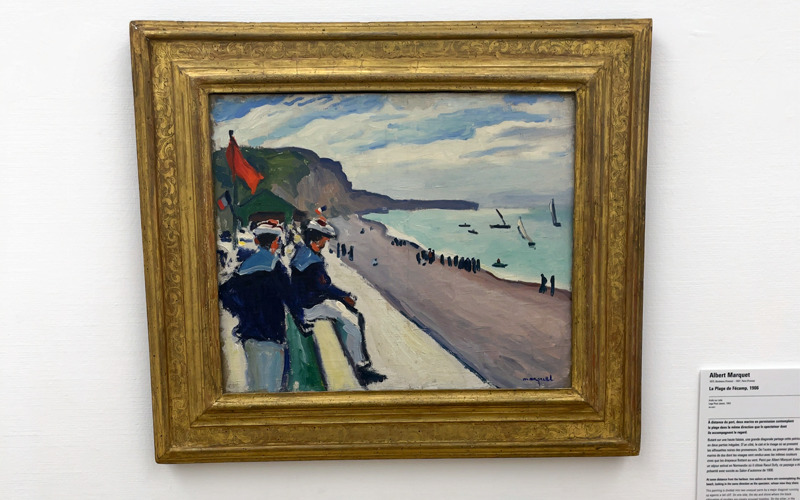
La plage de Fécamp (1906)
「La plage de Fécamp (1906)(フェカンの浜辺)」は、ノルマンディー地方のフェカンの浜辺の風景を描いています。
Maurice de Vlaminck (1876-1958)
絵画の手法をほとんど独学で身につけ、初期にはフィンセント・ファン・ゴッホの影響を強く受けた、モーリス・ド・ヴラマンク。
アンリ・マティスやアンドレ・ドランとともに、フォーヴィスム運動の中心的な役割を果たしました。
感情を直接的に表現するような、激しく力強い色彩と筆致が特徴で、対象の形態よりも色彩や筆致によって、感情や内面を表現することを重視しました。
風景画では、自然の力強さや荒々しさを、独特の色彩と筆致で表現しました。
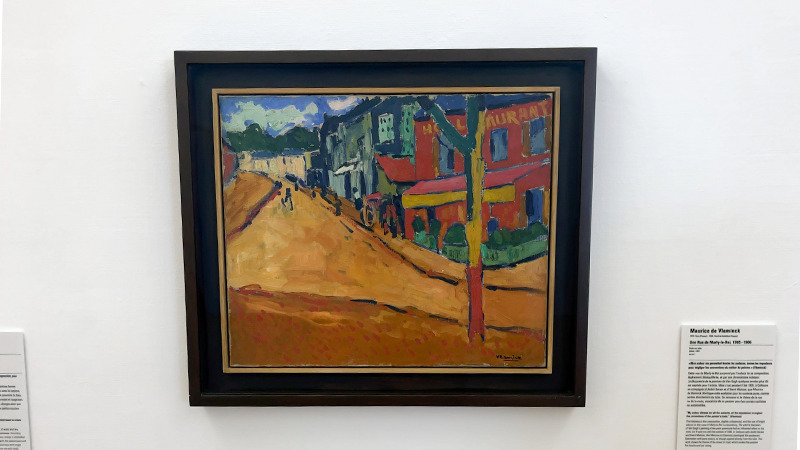
Une rue de Marly-le-Roi (1905-06)
「Une rue de Marly-le-Roi(マルリー=ル=ロワの通り)」は、フランス、イヴリーヌ県に位置するマルリー=ル=ロワの通りを描いた風景画です。
ヴラマンクの初期の代表作の一つであり、彼の情熱的で力強い表現が際立っています。
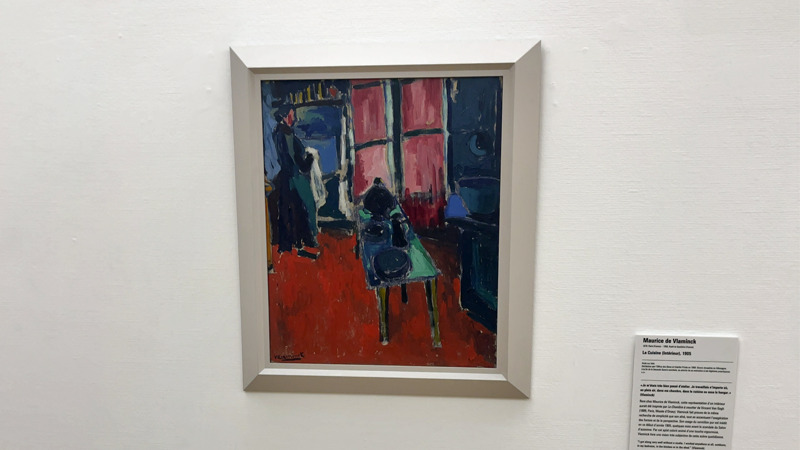
La Cuisine (Intérieur) (1905)
「La Cuisine (Intérieur)(台所(室内))」は、ヴラマンクの寝室からインスピレーションを得た作品です。
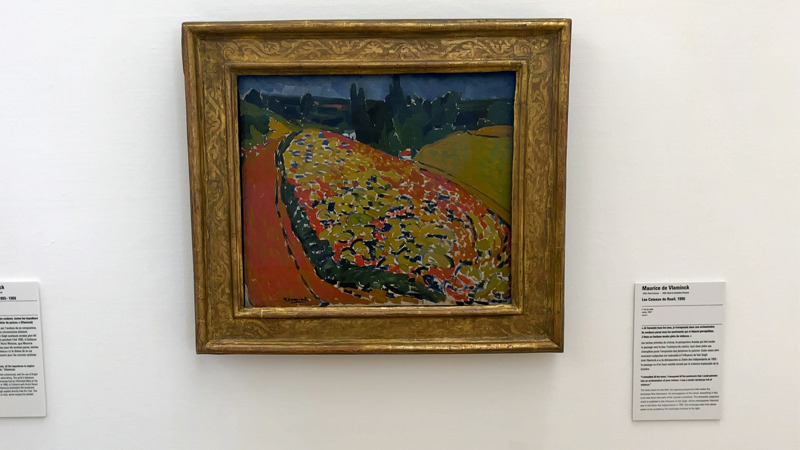
Les Coteaux de Rueil (1906)
「Les Coteaux de Rueil(リュイユの丘)」は、フランス、オー=ド=セーヌ県に位置するリュイユの丘の風景を描いた作品です。
流れる風景と遠近感、強烈な色彩が特徴的な作品です。
Raoul Dufy (1877-1953)
ラウル・デュフィ(Raoul Dufy, 1877-1953)は、フランスの画家であり、フォーヴィスム(野獣派)の代表的な作家の一人です。
「色彩の魔術師」と呼ばれるように、明るく軽やかな色彩と、流れるような線描が特徴的な作品を数多く残しました。
フォーヴィスムに分類されるデュフィですが、他のフォーヴィスムの画家とは少し違った美しい画風が特徴的です。
ル・アーヴル市立美術学校で美術を学び、その後パリの国立美術学校エコール・デ・ボザールへ入学しました。
アンリ・マティスの影響を受け、フォーヴィスムの画家として活動を始めましたが、後に独自の画風を確立しました。
絵画だけでなく、テキスタイル・デザインや舞台美術など、幅広い分野で活躍しました。
明るく軽やかな色彩と、流れるような線描が特徴で、 南仏の風景や競馬場、音楽などをモチーフに、優雅で装飾的な作品を制作しました。
水彩画にも才能を発揮し、タペストリーやステンドグラスなど、装飾芸術の分野でも活躍しました。
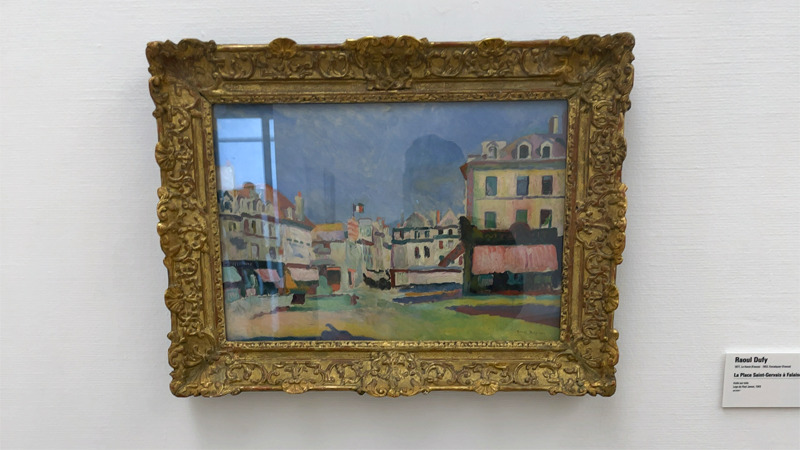
La Place Saint-Gervais à Falaise (1906)
「La Place Saint-Gervais à Falaise (1906)(ファレーズのサン=ジェルヴェ広場)」は、フランス、ノルマンディー地方のファレーズにあるサン=ジェルヴェ広場を描いた風景画です。
Emile Othon Friesz (1879-1949)
エミール・オトン・フリエス(Émile Othon Friesz, 1879-1949)は、フランスの画家であり、フォーヴィスム(野獣派)の代表的な作家の一人です。
ル・アーヴル出身の画家で、ラウル・デュフィ、アンリ・マティス、アルベール・マルケの友人でした。
後に、フォーヴィスムから離れ、より伝統的な絵画様式へと移行しました。
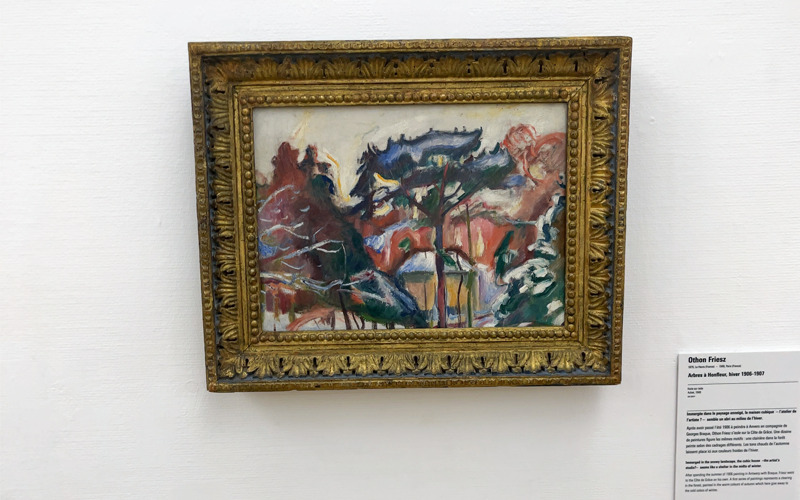
Arbres à Honfleur (1906-07)
「Arbres à Honfleur(オンフルールの木々)」は、フランス、ノルマンディー地方のオンフルールの風景を描いた作品です。
André Derain (1880-1954)
アンドレ・ドラン(André Derain, 1880-1954)は、フランスの画家であり、フォーヴィスム(野獣派)の中心的役割を果たした作家の一人です。
後に、フォーヴィスムから離れ、より伝統的な絵画様式へと移行しました。
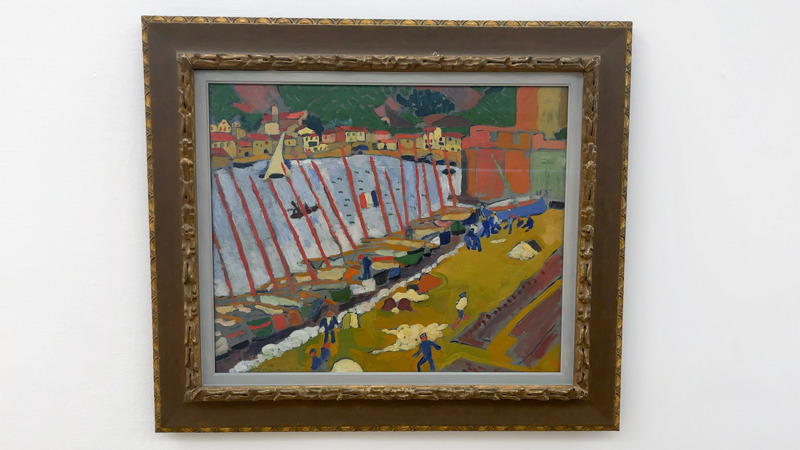
Le Faubourg de Collioure (1905)
「Le Faubourg de Collioure(コリウールの郊外)」は、フランス、ピレネー=オリアンタル県にあるコリウールの郊外の風景を描いた作品です。
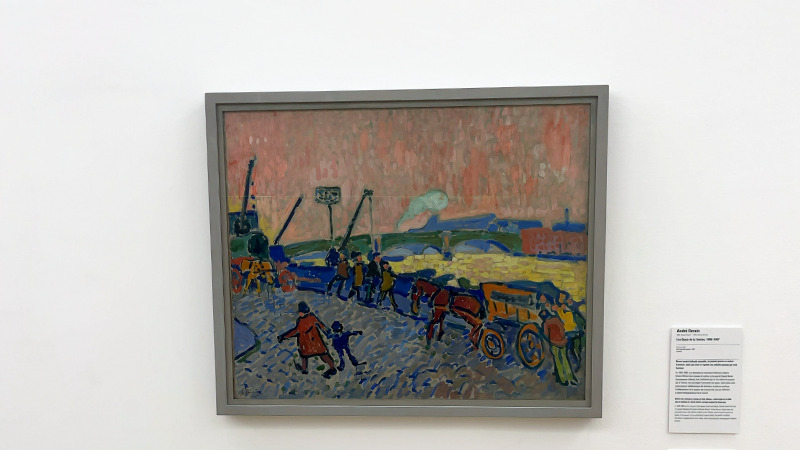
Les Quais de la Tamise (1906-07)
1905年から06年にかけて、渡英した際の作品です。
テムズ川の埠頭の様子を、フォーヴィスム(野獣派)の鮮烈な色彩と大胆な筆致で描いています。
Cubisme キュビスム
キュビスム(Cubisme)とは?
キュビスムは、20世紀初頭にパブロ・ピカソとジョルジュ・ブラックによって生み出された美術運動です。
伝統的な遠近法や単一の視点を否定し、対象を幾何学的な形に分解し、異なる視点を同時に表現することを特徴とします。
この運動は「分析的キュビスム」と「総合的キュビスム」の二つの段階に分かれます。
前者(1907~1912年)は、対象を細かく分割し、モノクロームに近い色調で描かれました。
後者(1912年以降)は、より装飾的で、コラージュ技法を取り入れるなど、多様な素材を用いた表現へと発展しました。
キュビスムは絵画だけでなく、彫刻や建築、デザインにも影響を与え、モダンアートの礎を築いた革新的な運動です。
Pierre Albert-Birot (1876-1967)
ピエール・アルベール=ビロは、フランスの詩人、劇作家、小説家、画家、活字デザイナーです。
1916年に詩誌「SIC」を発行し、ダダからシュルレアリスムへの移行を促す先駆的な役割を果たしました。
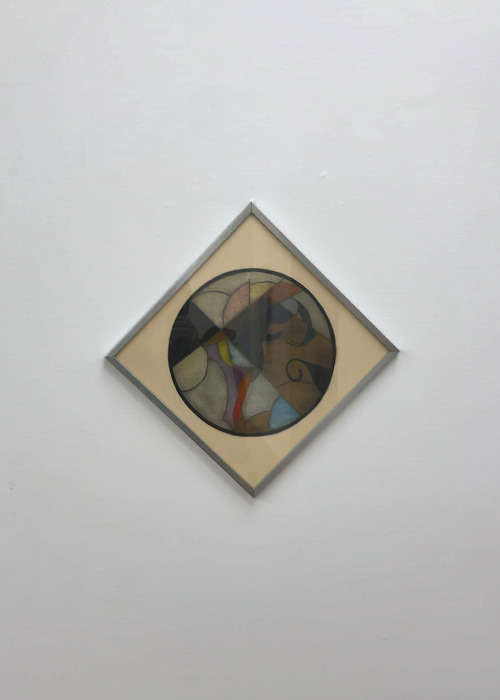
Femme nue dans une salle de bain (1916)
「浴室の裸婦」というタイトルの作品です。
Fernand Léger (1881-1939)
フェルナン・レジェは、フランスの画家であり、当初キュビスムの影響を受けましたが、次第にそこから離れ、機械的な要素を取り入れた、より力強く、明確なフォルムと色彩による独自のスタイルを確立しました。
絵画だけでなく、版画、陶器、舞台装置、映画など、幅広い分野で作品を制作しました。
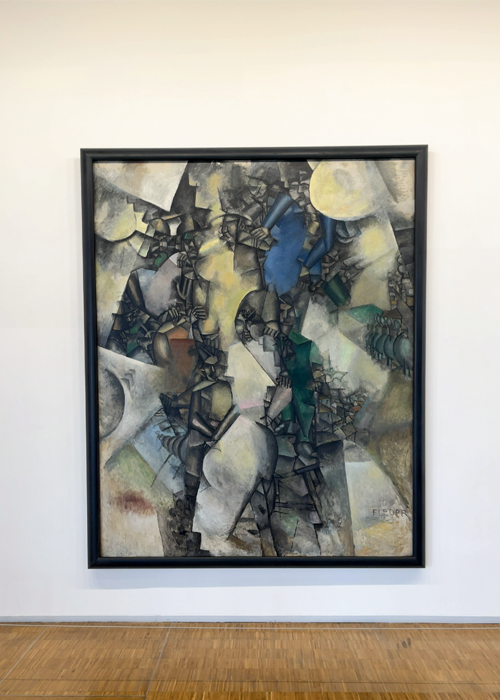
La Noce (1911-12)
「La Noce (結婚式)」はレジェの初期のキュビスム様式の作品であり、幾何学的な形態と鮮やかな色彩が特徴です。
結婚式の場面を、伝統的な描写ではなく、レジェ独自の視点から抽象的に表現しています。
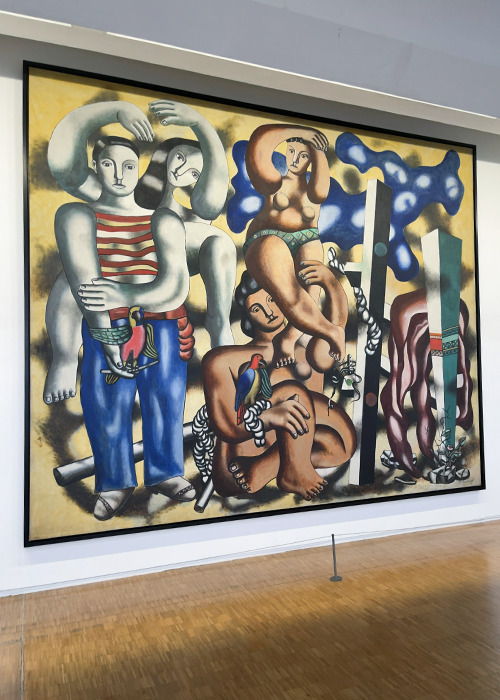
Composition aux deux perroquets (1935-39)
「Composition aux deux perroquets(二羽のオウムの構成)」は、二羽のオウムを、幾何学的で力強いフォルムと、鮮やかな色彩で描いています。
キュビスムの影響を受けた画家として知られていますが、後半生は太い輪郭線を使った独自の画風を形成していきます。
ル・コルビュジエとの出会いが影響していると言われている作品です。
Georges Braque (1882-1963)
ジョルジュ・ブラックは、20世紀初頭のフランスを代表する画家です。
- キュビスムの創始者:
- ピカソとともに、従来の絵画の概念を根本から覆すキュビスムを創始しました。
- 対象を幾何学的な形態に分解し、複数の視点から同時に描くことで、新しい空間表現を追求しました。
- 独自のスタイル:
- ピカソと共同でキュビスムの基礎を築いた後も、独自のスタイルを追求し続けました。
- 晩年には、より詩的で装飾的な要素を取り入れた作品を制作しました。
- 静物画の名手:
- 特に静物画において、その才能を発揮しました。
- 身近なモチーフを、洗練された色彩と構成で描き出し、深い精神性を表現しました。
- 多岐にわたる活動:
- 絵画だけでなく、彫刻、版画、舞台美術など、多岐にわたる分野で活躍しました。
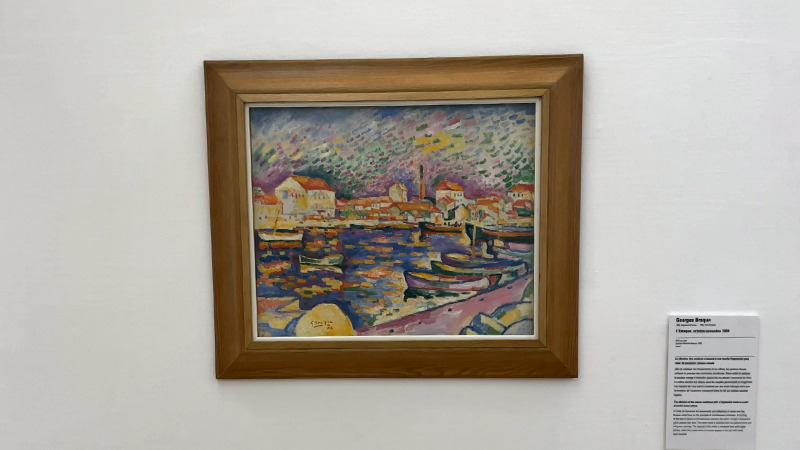
L’Estaque (1906)
南フランス、マルセイユ近郊の街、レスタックという港町を描いた風景画です。
フォーヴィスムの影響を強く受けていて、鮮やかで大胆な色彩と、力強い筆致が特徴的ですが、対象を単純化し、幾何学的な形態で表現する傾向が見られます。
ブラックは、この作品を通じて、伝統的な風景画の概念を打ち破り、新しい絵画表現を模索しました。
この作品は、ブラックが後にキュビスム(立体派)へと進む上で、重要なステップとなった作品です。
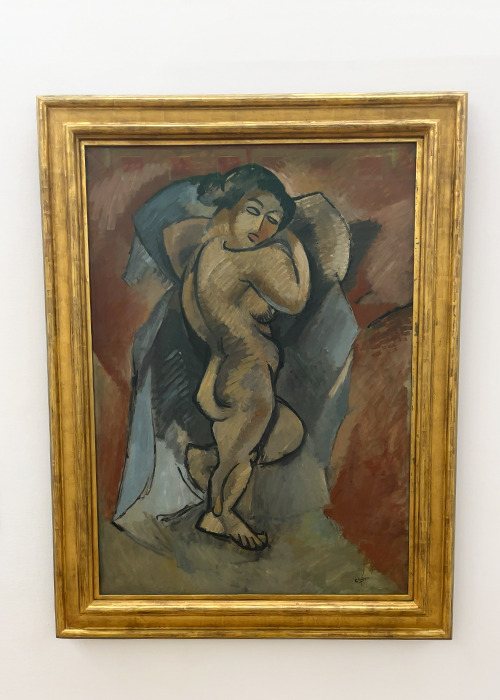
Grand Nu (1907-08)
ブラックが書いた、最初のキュビスムの作品と言われている記念碑的な作品です。
伝統的な裸婦像とは異なり、対象を幾何学的な形態に分解し、複数の視点から同時に描くことで、新しい空間表現を試みています。
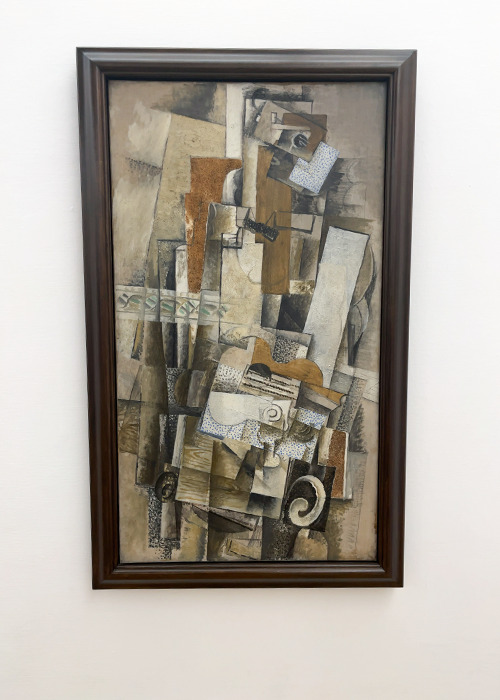
L’Homme à la guitare (1914)
エリック・サティの友人でもあるブラックは、音楽からインスピレーションを受けた作品を多く手掛けています。
ギターを演奏する男性が、幾何学的な形に分解され、再構成されています。
Auguste Herbin (1882-1960)
オーギュスト・エルバンは、フランスの画家であり、幾何学的抽象絵画の先駆者の一人として知られています。
- 初期からキュビスムへ
- 初期には印象派やフォーヴィスムの影響を受けましたが、その後キュビスムへと移行しました。
- 独自の抽象絵画
- 1917年頃から、対象を単純な幾何学的形態に分解し、純粋な色彩と形で構成された独自の抽象絵画を追求しました。
- 彼の作品は、厳格な幾何学的構造と鮮やかな色彩が特徴です。
- 「プラスチック・アルファベット」
- 晩年には、色彩と形態を体系的に結びつける「プラスチック・アルファベット」と呼ばれる理論を提唱し、その理論に基づいて作品を制作しました。
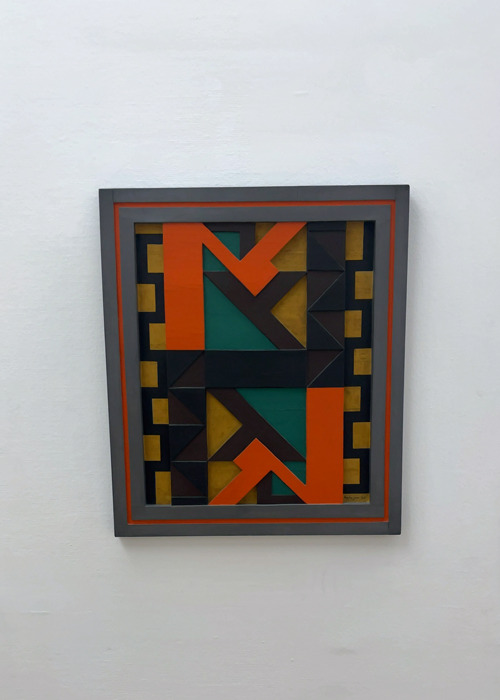
Relief polychrome (1921)
作品は彫刻絵画であり、幾何学模様を上下部で反転させています。
エルバンの抽象絵画の初期の代表作の一つとされています。
Orphisme オルフィスム
オルフィスム(Orphisme)とは?
オルフィスムは、20世紀初頭のフランスで生まれた前衛芸術運動で、キュビスムから派生しながらも、より鮮やかな色彩と動的な表現を追求したスタイルです。
ロベール・ドローネーとその妻ソニア・ドローネーを中心に展開され、詩人ギヨーム・アポリネールによって「オルフィスム」と名付けられました。
この運動の特徴は、キュビスムの幾何学的な形態を受け継ぎつつも、強い色彩のコントラストや光の効果を重視し、音楽的なリズムを感じさせる構成にあります。
伝統的な具象性から離れ、純粋な抽象表現へと向かう過程で、後の抽象絵画や現代デザインにも影響を与えました。
オルフィスムは短命な運動でしたが、色彩のダイナミズムと抽象性の探求において重要な役割を果たしました。
František Kupka (1871-1957)
フランティシェク・クプカは、チェコ出身の画家で、抽象絵画の先駆者の一人として知られています。
- 抽象絵画のパイオニア
- カンディンスキーやマレーヴィチらとともに、抽象絵画の初期の発展に貢献しました。
- 1911年から1912年頃には、完全に抽象化された作品を制作していました。
- 初期から抽象絵画へ
- 初期には、象徴主義的な具象絵画を制作していました。
- その後、パリに移り、キュビスムの影響を受けながら、次第に抽象化を進めていきました。
- 色彩と形の探求
- クプカは、色彩と形の関係性を深く探求し、独自の抽象絵画のスタイルを確立しました。
- 彼の作品は、生命力にあふれた色彩と、多様な形の組み合わせによって、宇宙の生成や生命の動きを表現しようと試みています。
- 晩年の評価
- 生前は、その革新的な作風が十分に理解されませんでしたが、死後、その全体像が明らかにされ、近年ますます高い評価を受けています。
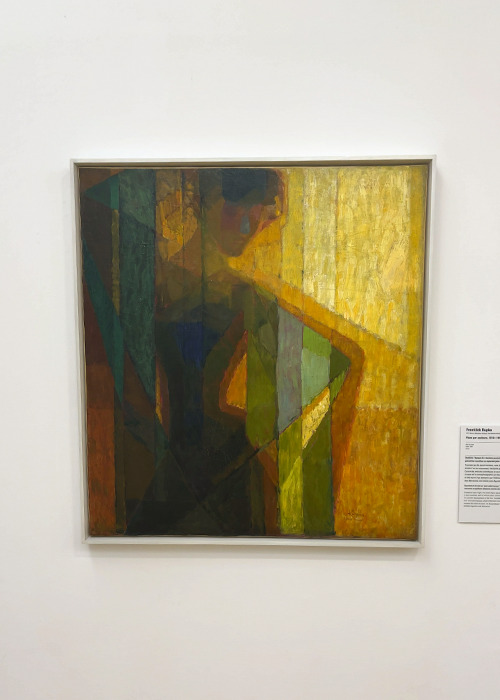
Plans par couleurs (1910-11)
科学の進歩に興味を持っていたクプカならではの作品です。
クロノ写真やX線にインスピレーションを受けていました。
明るい色の帯が画面にリズムを与え、光の揺らぎや動的な印象を生み出しています。
この作品は、色彩を主体とした絵画表現の可能性を追求した点で、カンディンスキーやモンドリアンと並び、20世紀の抽象絵画の先駆者としてのクプカの位置を確立する重要な役割を果たしました。
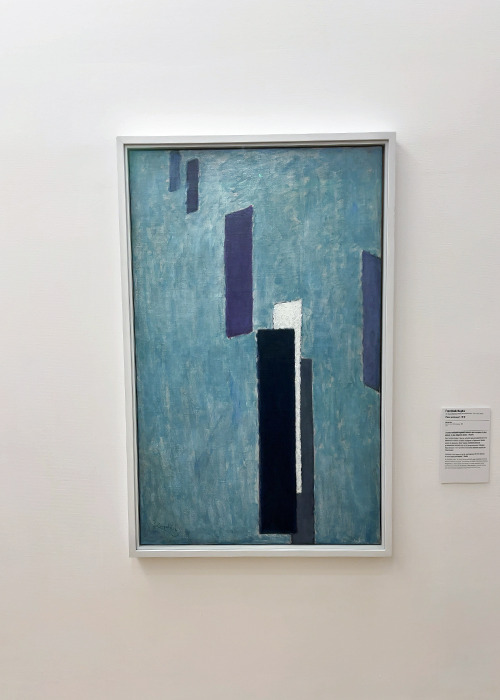
Plans verticaux I (1912)
フランス国家が取得した最初の抽象的な作品です。
画面全体に垂直の帯状の色面が配置され、色彩のリズムと動きを生み出しています。
色と形が調和し、まるで音楽の旋律が視覚化されたような効果を持っています。
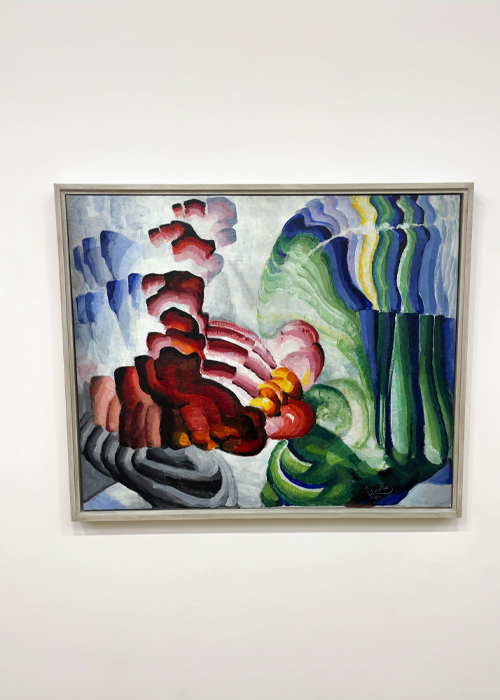
Compliment (1912)
男性と女性の二人が挨拶する様子を描いています。
鮮やかな色彩が幾何学的な構成の中で調和し、視覚的なリズムを生み出しています。
タイトルの「Compliment(賛辞)」は、視覚的な美しさや調和を称える意味を持ち、抽象絵画が感覚的な体験を生み出すことを示唆しています。
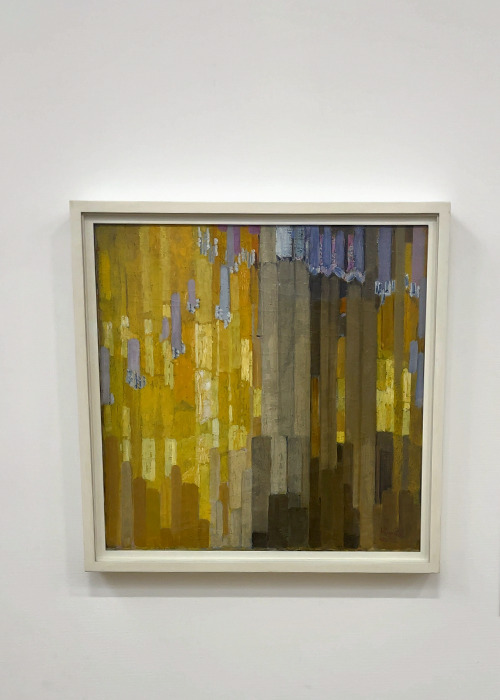
Ordonnance sur verticales en jaune (1913)
ピアノの鍵盤を思わせる作品で、クプカが音楽に関心があることが伺えます。
タイトルの「verticales(垂直)」が示すように、縦に並ぶ形と線のリズムが印象的です。
具象から離れ、リズミカルな構成と色彩のバランスを探求するクプカの意図が表れています。
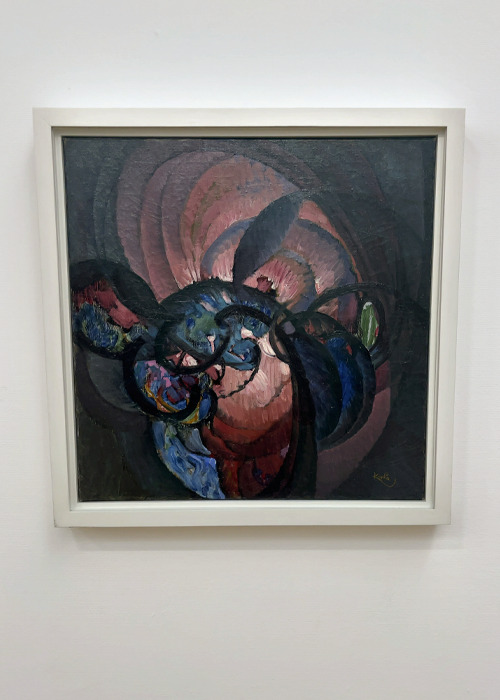
Traits noirs enroulés (1911-20)
渦巻く黒い線(Traits noirs enroulés)というタイトルの通り、黒い線が画面上で動的に絡み合い、リズミカルな構成を生み出しています。
黒い線と周囲の色彩が対照的に配置され、視覚的なダイナミズムを強調しています。
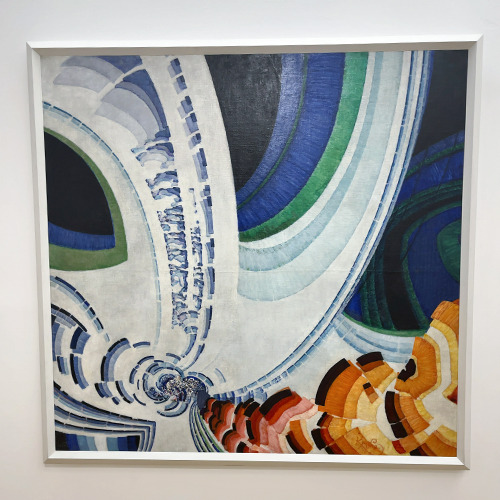
Lignes animées (1920-23)
天文学からインスピレーションを受けた作品です。
抽象的な線と色彩で、宇宙の動きやエネルギーを表現しています。
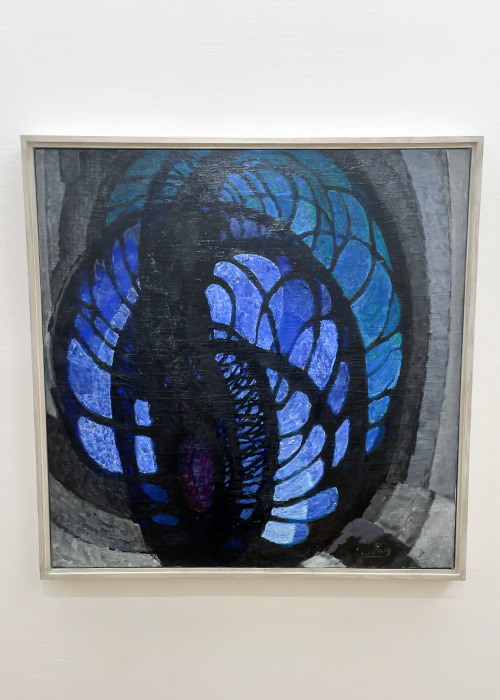
Traits, plans et profondeur I (1920-22)
ソルボンヌ大学で生物学を学んでいたクプカ。
「Traits, plans et profondeur I(線、平面、そして奥行き I)」は、心臓の血管からインスピレーションを得て描かれた作品になっています。
線と平面、そして奥行きを組み合わせることで、生命の神秘や躍動感を表現しています。
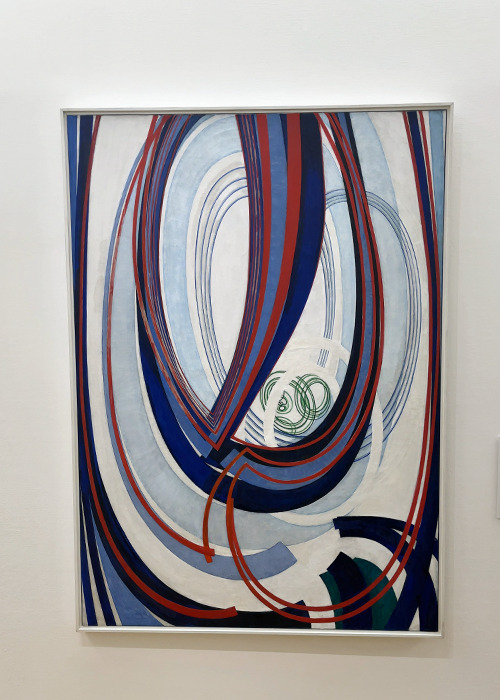
Traits, plans, espace III (1921-27)
「Traits, plans, espace III(線、平面、空間 III)」は、線と円、そして色の使い方で空間を描いています。
1912年頃からクプカが長年取り組んでいるテーマになります。
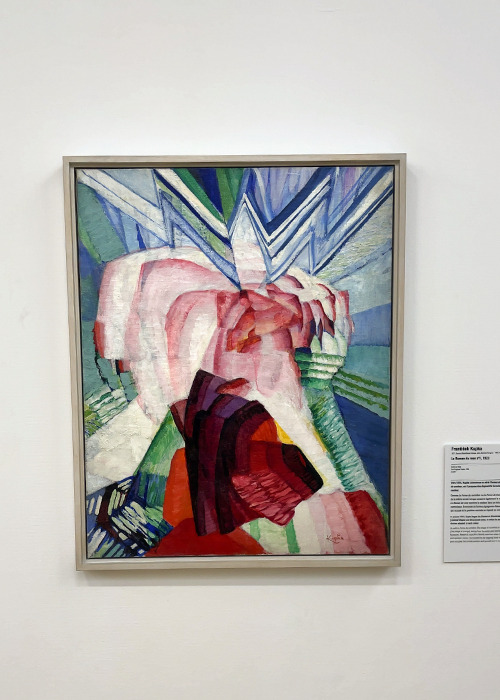
Le Roman du rose n°1 (1923)
「Le Roman du rose n°1(薔薇物語 n°1)」は、クプカが長年探求してきた抽象表現の集大成とも言える作品です。
薔薇をモチーフにしていますが、具象的なイメージはほとんどなく、色彩と形態の純粋な構成によって、薔薇の持つ美しさや生命力を表現しています。
Robert Delaunay (1885-1941)
ロベール・ドローネーはフランスの画家で、20世紀初頭の前衛芸術運動において重要な役割を果たしました。
彼は色彩の理論と光の表現に特に関心を持ち、「オルフィズム」と呼ばれる独自の抽象芸術スタイルを妻のソニア・ドローネーと共に発展させました。
オルフィズムは、キュビスムから発展しつつも、より鮮やかな色彩と円形の幾何学的形態を特徴としています。
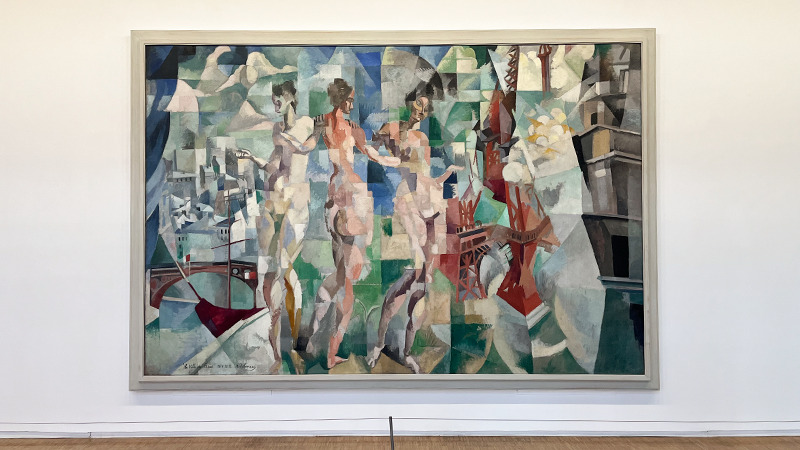
La Ville de Paris (1910-12)
パリの都市風景を、キュビスムとオルフィスムの要素を融合させた独特のスタイルで描いています。
エッフェル塔、セーヌ川、ノートルダム大聖堂など、パリの象徴的な建造物が、鮮やかな色彩と幾何学的な形態で表現されています。
都市のダイナミズムやエネルギーを、色彩と光の相互作用によって表現しようとした、ドローネーの代表作の一つです。
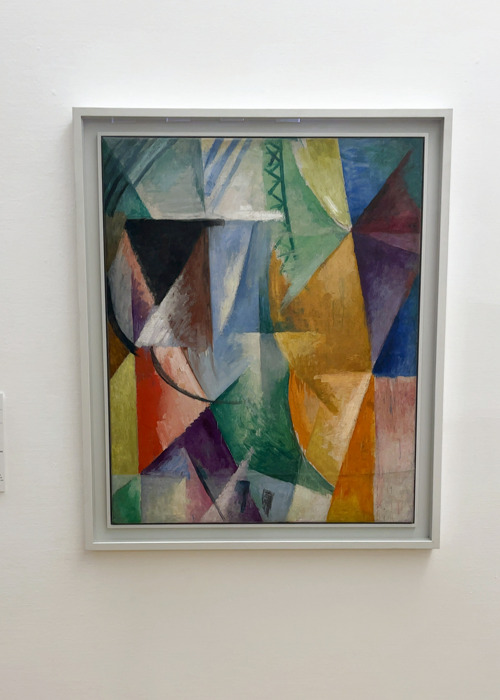
Une fenêtre (1912)
フランス語で「窓」を意味する作品です。
窓から見える都市の風景を、鮮やかな色彩と幾何学的な形態で表現しています。
光と色彩の相互作用によって生まれる、ダイナミックで抽象的な空間表現が特徴です。
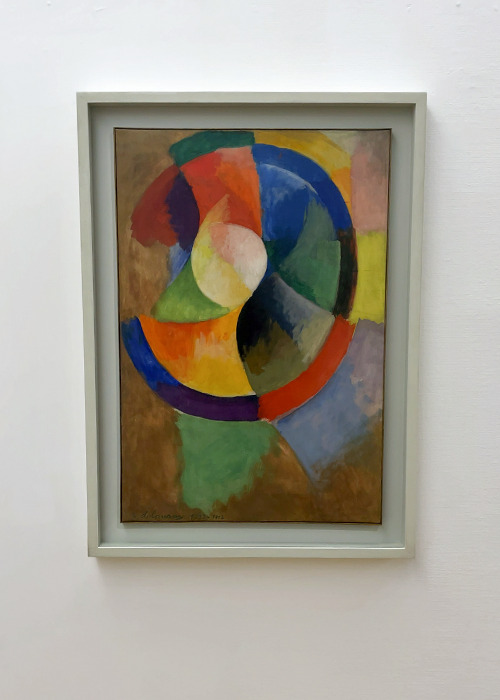
Formes circulaires, Soleil n° 2 (1912-13)
「円形の形、太陽 No. 2 」は、太陽をモチーフに、鮮やかな色彩と幾何学的な形態で構成されています。
円形の形態が画面全体に配置され、色彩のグラデーションによって、光の拡散や動きが表現されています。
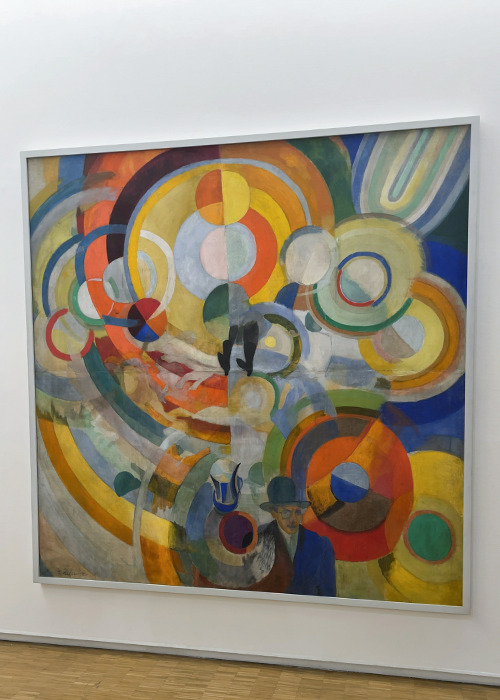
Manège de cochons (1922)
この絵は、カラフルな円盤が渦巻く中に黒い脚が巻き込まれ、活気ある遊園地の雰囲気を再現しています。
色彩豊かな円盤は音楽と回転木馬のような動きを生み出し、観客を引き込みます。
近代都市の広告やスポーツ、大衆ショーは画家に新たな刺激を与えました。
前景にはダダ詩人トリスタン・ツァラが描かれ、ロベールとソニア・ドローネー夫妻と詩の関わりを示してます。
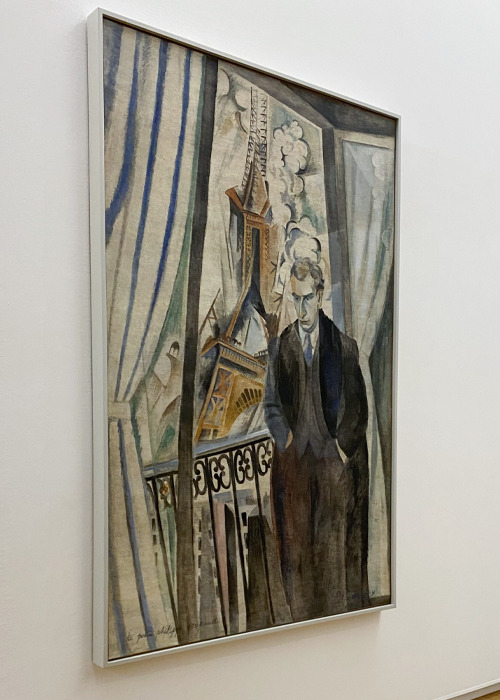
Le poète Philippe Soupault (1922)
「詩人フィリップ・スーポー」は、当時の前衛的な詩人フィリップ・スーポーの肖像画であり、ドローネーの独特な色彩感覚と抽象的な表現が際立つ作品です。
スーポーの人物像を、幾何学的な形と鮮やかな色彩で表現しています。
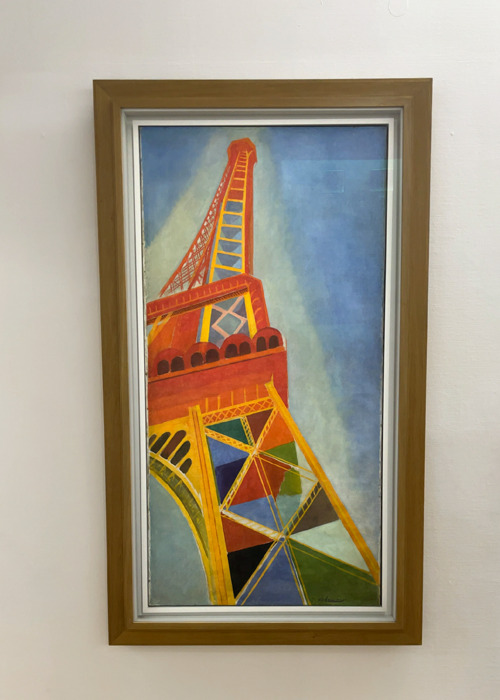
La Tour Eiffel (1926)
ローアングルから描いたエッフェル塔になります。
彼が繰り返し描いたエッフェル塔を主題にした一連の作品の中でも、特に重要な作品の一つです。
Sonia Delaunay (1885-1979)
ソニア・ドローネーは、ロシア帝国(現在のウクライナ)出身のフランスの画家、テキスタイルデザイナー、舞台美術家です。夫のロベール・ドローネーとともに、オルフィスム(色彩キュビスム)と呼ばれる芸術運動を創始しました。
- オルフィスムの創始:
- 夫のロベール・ドローネーとともに、色彩の相互作用と幾何学的な形を用いた抽象絵画のスタイルであるオルフィスムを確立しました。
- 色彩の持つ力強い表現力を追求し、絵画だけでなく、テキスタイル、ファッション、舞台美術など、幅広い分野でその才能を発揮しました。
- 多岐にわたる活動:
- 特に、テキスタイルデザインにおいては、大胆な色彩と幾何学的なパターンを用いたデザインで、当時のファッション界に大きな影響を与えました。
- 晩年の評価:
- 存命中にルーブル美術館で回顧展が開かれるなど、女性芸術家としては異例の高い評価を受けました。
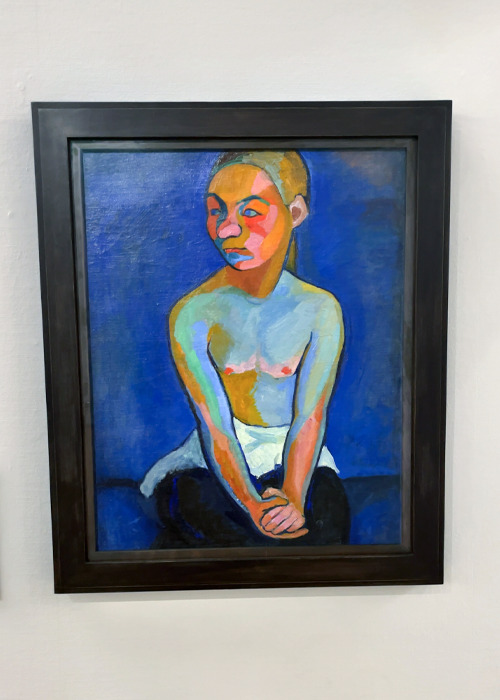
Jeune Finlandaise (1907)
フィンランドでの休暇中に制作され、フィンランドの民族衣装を身にまとった若い女性を描いています。
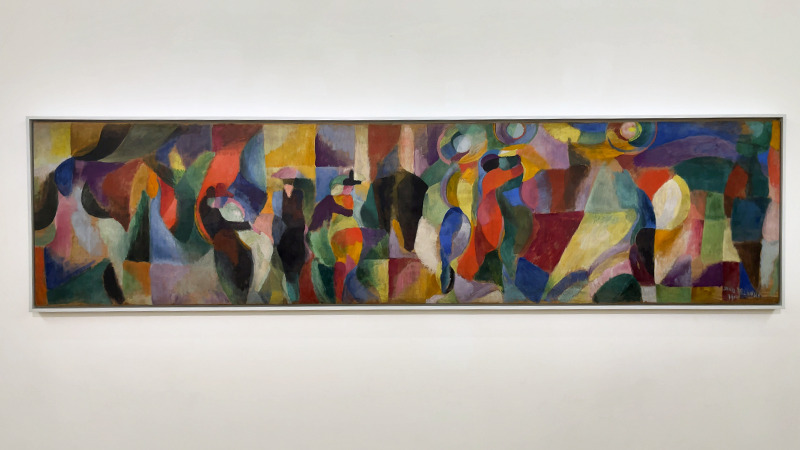
Le Bal Bullier (1913)
サン・ミッシェル通りにあるダンスホール「バル・ブリエ」での様子を描いた作品です。
鮮やかな色彩と幾何学的な形によって、踊りや音楽の動き、人々の熱気を表現しています。
色彩のコントラストと、大胆な構図が特徴であり、彼女の作品の特徴である、色彩の持つ力強い表現力が際立っています。
オルフィスムらしい作品となっています。
まとめ
抽象画の発展に「キュビスム」が与えた影響はもの凄く大きなものです。
ピカソとブラックがキュビスムを世に広めなければ、今日の抽象画は全く違ったものになっていたかも知れません。
(しかし、二人共結局は「キュビスム」を放棄してしまうのですが)
次回は同時期に起こった他国での芸術運動を中心にご紹介させて頂きたいと思います。
今回も最後までお読み頂きありがとうございました。
国立近代美術館のコレクションについては以下の記事で詳しくご紹介させて頂いております。合わせてご参照ください。
- ポンピドゥー・センター コレクション|ピカソとシャガール:フランス近代美術の二大巨匠
- 色彩の爆発と造形の革新:フォーヴィスム、キュビスム、オルフィスム – ポンピドゥー・センター・コレクション
- ポンピドゥー・センター:表現主義、青騎士、未来派 – カンディンスキーと革新の絵画
- ポンピドゥー・センター:シュプレマティスム、デ・ステイル、形而上絵画 – 抽象美術の多様性
- ポンピドゥー・センターで見る前衛芸術の衝撃 ダダイスムとシュルレアリスム
- ポンピドゥー・センター:アンフォルメル、タシスム、CoBrA、ヌーヴォー・レアリスム – 戦後美術の多様な展開
- 内面と大衆文化、そして概念の探求:抽象表現主義、ポップアート、コンセプチュアル・アート – ポンピドゥー・センター・コレクション

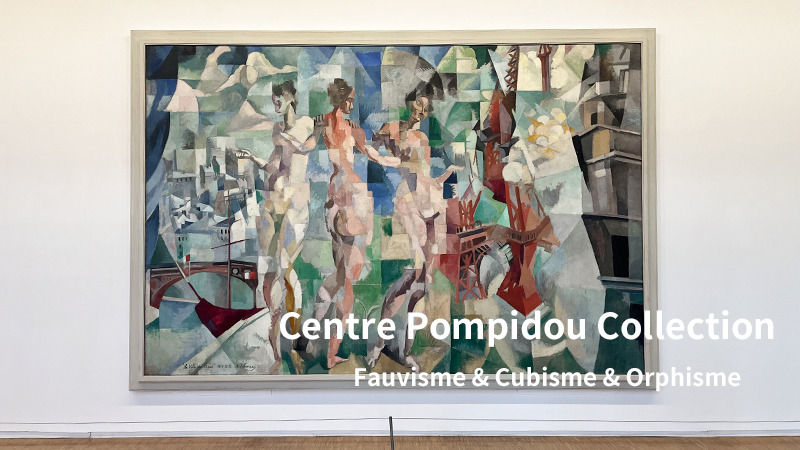


コメント